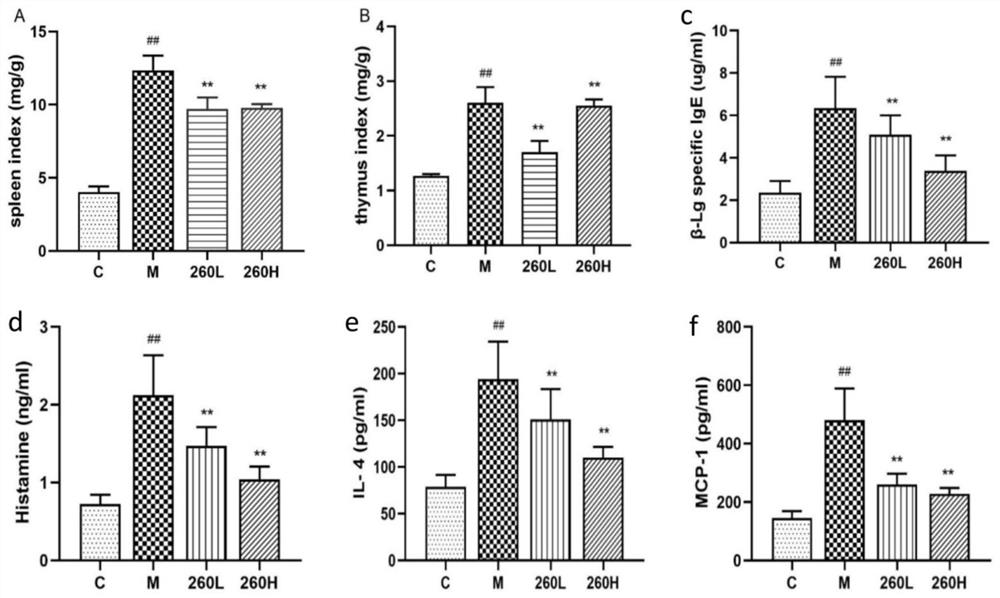Lactobacillus rhamnosus and application thereof
A technology for preservation of Lactobacillus rhamnosus and strains, which is applied in the field of probiotics and achieves the effects of excellent simulated gastrointestinal fluid tolerance and inhibition of Escherichia coli
- Summary
- Abstract
- Description
- Claims
- Application Information
AI Technical Summary
Problems solved by technology
Method used
Image
Examples
Embodiment 1
[0040] (1) Isolation and purification of strains
[0041]1) Sample collection: Sampling and numbering were carried out in 50mL sterile centrifuge tubes in Nanshan pasture (different milk stations), Wangcheng (dairy company and pasture) and Ningxiang (dairy company and pasture) in Hunan Province respectively, and used a sampling box containing ice packs Rapid transport to microbiology laboratory; a total of 71 samples were collected from these areas.
[0042] 2) Isolation of lactic acid bacteria: under aseptic conditions, 25 g of the sample was taken and mixed in a 500 mL Erlenmeyer flask containing 225 mL of sterile normal saline (0.85% NaCl), and diluted to 10 with a 10-fold gradient. -2 ~10 -6 , and in the MRS solid (containing 0.5% CaCO 3 (w / v)) were coated on the plate, and cultured at 37° C. for 48 h. Pick a single colony with a transparent calcilytic circle for Gram staining, and purify the positive strains by streaking three times and save them by numbering. All the...
Embodiment 2
[0082] Example 2 In vivo evaluation of bacterial count antiallergic activity in mice
[0083] (1) Activation of the strain
[0084] After activating the original strain of Lactobacillus rhamnosus AU9260 stored in a -80°C refrigerator for 2 generations, streak it on the solid MRS medium, culture it statically at 37°C for 72 hours, and then pick a single colony and inoculate it in the MRS liquid medium , after constant temperature cultivation at 37°C for 24 hours, inoculate into liquid MRS medium according to 1% (v / v) inoculum amount, and continuously culture for 2 generations.
[0085] (2) Preparation of bacterial suspension
[0086] The activated Lactobacillus rhamnosus AU9260 was inoculated in MRS liquid medium, cultivated at 37°C for 24 hours, and then centrifuged at 8 000 r / min for 4 minutes to collect the bacterial pellet, then resuspended in PBS buffer, and adjusted the bacterial concentration to 10 8 CFU / mL, 10 10 CFU / mL.
[0087] (3) Construction of animal models
...
Embodiment 3
[0130] Example 3 Effect of β-lactoglobulin-sensitized mice on intestinal flora
[0131] (1) Establishment of mouse model
[0132] The mouse models in this example were established according to Example 2.
[0133] (2) DNA extraction from mouse feces samples
[0134] The fresh feces of mice in each group were collected, frozen in time at -80°C, and genomic DNA was extracted using a DNA extraction kit according to the instructions.
[0135] (3) PCR amplification
[0136] The DNA extracted in the previous step was used as a template for amplification, and the amplified region was the V3-V4 region of the bacterial 16S rRNA gene. Primer sequences, amplification systems, and amplification conditions are shown in Tables 7, 8, and 9.
[0137] Table 7 Primer Sequence
[0138]
[0139] Table 8 Amplification system
[0140]
[0141]
[0142] Table 9 Amplification Conditions
[0143]
[0144] (4) Detection, merging and purification of PCR products
[0145] After the amp...
PUM
 Login to View More
Login to View More Abstract
Description
Claims
Application Information
 Login to View More
Login to View More - R&D
- Intellectual Property
- Life Sciences
- Materials
- Tech Scout
- Unparalleled Data Quality
- Higher Quality Content
- 60% Fewer Hallucinations
Browse by: Latest US Patents, China's latest patents, Technical Efficacy Thesaurus, Application Domain, Technology Topic, Popular Technical Reports.
© 2025 PatSnap. All rights reserved.Legal|Privacy policy|Modern Slavery Act Transparency Statement|Sitemap|About US| Contact US: help@patsnap.com



